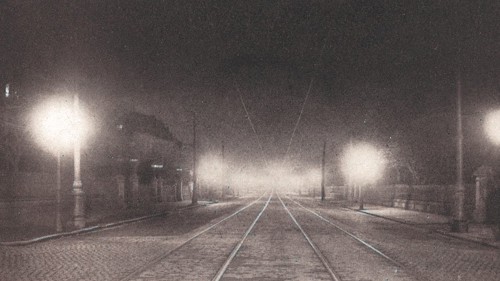Street Lighting - Times Past

In partnership with the Glasgow Times, our archivists are exploring Glasgow's fascinating history. This week, Michael Gallagher sheds some light on the lighting of the city's streets.
The first street lamps in Glasgow – cone shaped, oil lanterns – were thought to have been erected in 1717. There were so few of them and the light they provided was so weak, however, that the city was still hard to circumnavigate without moonlight.
The Town Council recognised the problem in 1767, expressing the opinion that more lamps would be good for its citizens, but the lack of public funds limited the action it could take. Lighting of streets eventually became a statutory duty in 1800 although the legislation had a narrow scope and was never taken particularly seriously.
In 1815 the staff of Glasgow’s Lighting Department consisted of a superintendent and only 11 lamplighters, reduced to two during the summertime.
The advent of gas lighting improved the situation greatly. In September 1818, a century after the first rudimentary street lights in the city, Glasgow lit its first gas lamp. The previous year, the Glasgow Gas-Light Company was formed by Act of Parliament and authorised to manufacture gas for the city. This was a joint venture between the Corporation and private investors and proved extremely profitable, coming fully under municipal control in 1869.
By that point the Glasgow Corporation had been granted the power to erect and maintain lamps in all public and private streets, illuminate all turret clocks and city timepieces, and establish a department under the control of an inspector of lighting.
This progress didn’t please everyone, however. One account sometime later lamented the improvements because they “removed for ever the opportunity for those many strange adventures which had occurred in tall tenements entered by unlighted and narrow stairs, and which had been due to the want of compulsory and systematic lighting in the city.”
Unfortunately for this critic, Glasgow saw the light rapidly. In 1870 the department employed 294 men to look after the city’s 10,657 lamps. By 1900, this increased to 710 men and 19,418 lamps and, by the outbreak of the First World War, 1050 men were tasked with maintaining more than 25,000 lamps.
By the turn of the century, electricity was becoming a major source of illumination. To meet demand the city opened two new generating stations in 1900 – Port Dundas in the north and Eglinton Toll in the south – whilst the independent burghs of Partick and Govan also erected their own.
For much of the twentieth century Glasgow was lit by both gas and electricity, and in 1960 the Corporation still employed 617 lamplighters and 11 “pole erectors”. The decade that followed saw electricity take over.
In 1971 the last remaining gas street lamp, on North Portland Street, was ceremonially lit by Lord Provost Sir Donald Liddle. The flame flickered into life and eventually dimmed, and with it went an illuminating part of Glasgow’s history.
